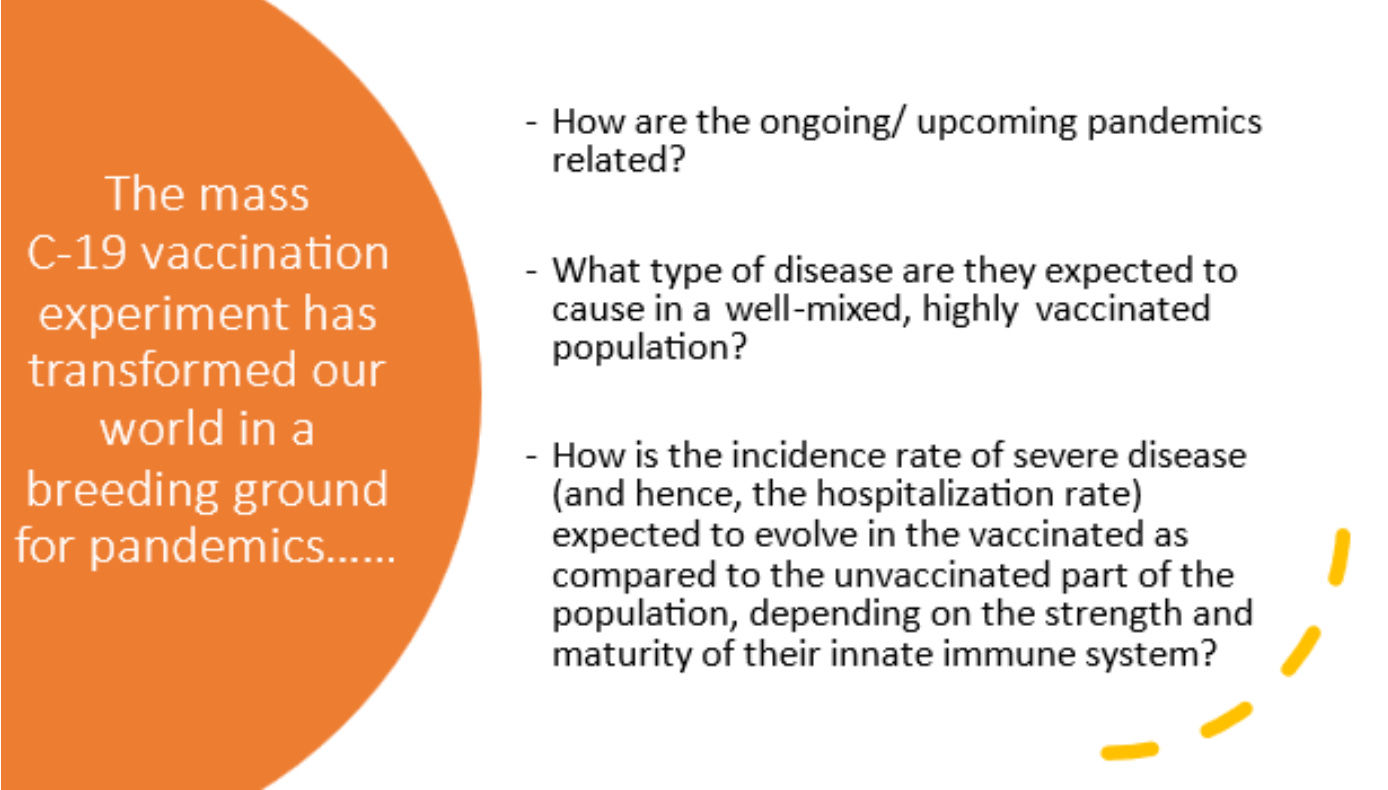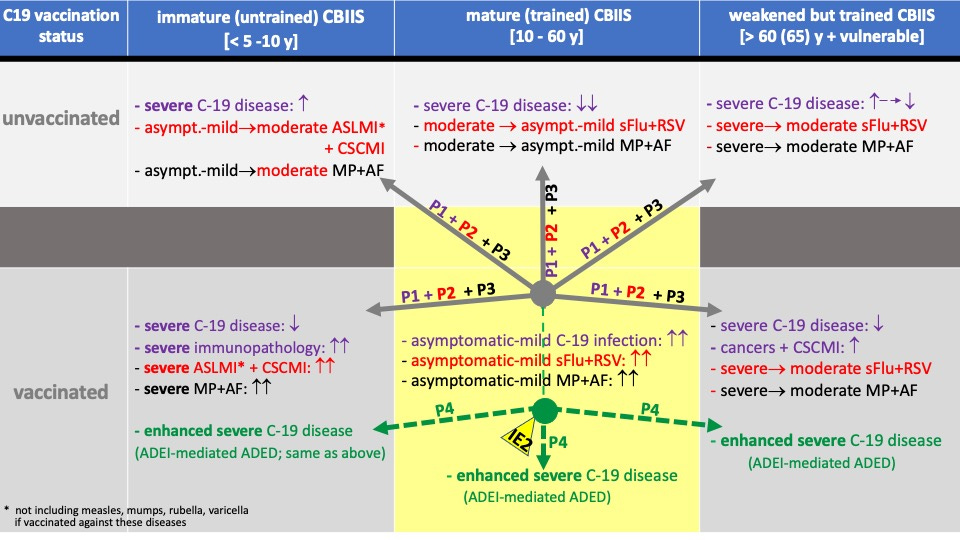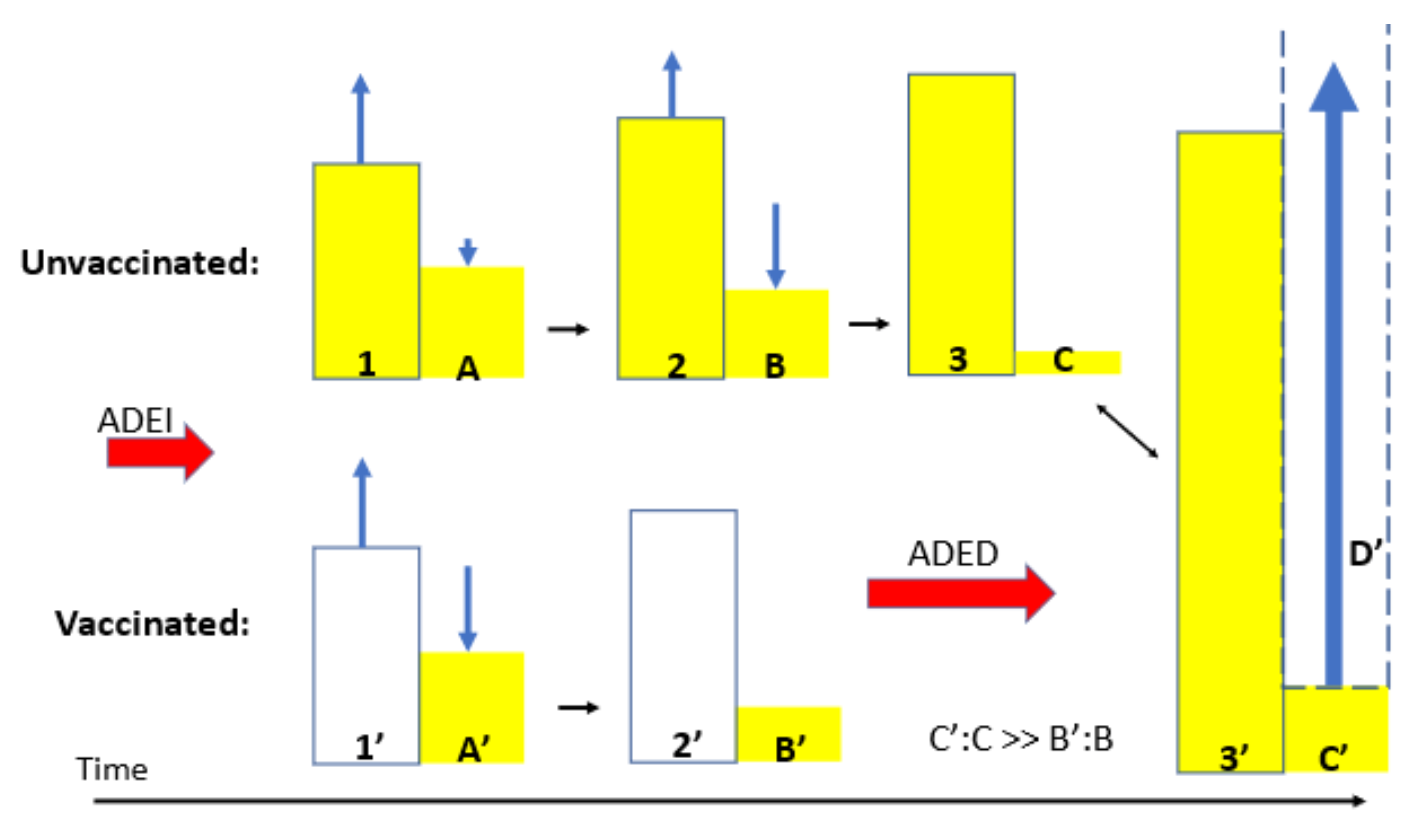Immuno-epidemiologic ramifications of the C-19 mass vaccination experiment: Individual and global health consequences
The mass vaccination program has driven natural selection and adaptation of more infectious SARS-CoV-2 (SC-2) variants that have now evolved to causing enhanced susceptibility of vaccinees to infection (due to antibody-dependent enhancement of infection; ADEI). The resulting recurrence of infectious episodes leads to hyperactivation of cytotoxic CD8+ T cells that are directed at a universal (i.e., MHC-unrestricted) T cell epitope comprised within the SC-2 spike (S) protein. As these cytotoxic CD8+ T cells enable prompt abrogation of productive infection and as this epitope is shared amongst some other glycosylated viruses causing acute self-limiting infection or disease, more and more cases of asymptomatic infections are to be expected in vaccinees, especially in those endowed with a mature and fully functional innate immune system. These asymptomatic infections are not limited to more infectious and antigenically shifted SC-2 variants but also include other infections that use the same cytotoxic T cells (CTLs) to abrogate productive infection (e.g., influenza virus, poxvirus, respiratory syncytial virus [RSV]). However, as prevention of disease in vaccines is, therefore, no longer based on prevention of infection by neutralizing antibodies, asymptomatic vaccinees abundantly spread highly infectious SC-2 immune escape variants as well as other highly infectious, immunogenically related viruses to other parts of the population. Consequently, in a highly vaccinated, well-mixed population, vaccinees with a mature and healthy innate immune system are now to be considered an asymptomatic reservoir for transmission of new, highly infectious SC-2 immune escape variants and other highly infectious diseases to the remainder of the population. The resulting enhanced viral transmission rate is likely to ignite new pandemics (see fig. 1), not only of new, highly infectious, and antigenically shifted SC-2 variants (typically labeled as ‘variants of concern’) but also of avian influenza virus and monkeypox virus. Elderly vaccinees could serve as an asymptomatic reservoir for less infectious immunogenetically related viruses such as RSV or common influenza strains. Transmission of RSV or influenza virus from asymptomatic vaccinated elderly to young children could disconnect the occurrence of these diseases from seasonality and hence, lead to a ‘childhood’ pandemic of RSV and influenza (currently already causing hospitalizations of children). Pseudo herd immunity (i.e., generated by continuous activation of cross-reactive cytotoxic CD8+ T cells) is currently mitigating the severity of the three major pandemics (i.e., P1, P2, P3: see chart attached below) in that it largely prevents cases of severe infectiousdisease in the bulk of highly vaccinated populations with cases of severe disease now only occurring in a limited number of young children. However, this situation is anything but stable and will only last for as long as the dominant Omicron (sub)variants are not fully resistant to the vaccine-induced infection-enhancing antibodies (Abs). In the meantime, though, continuous boosting of highly vaccinated populations by the circulating Omicron (sub)variants is highly likely to soon enable the virus to break through this adaptive immune defense. When this happens, no single immune defense mechanism will be left to fight off the virus, which will take advantage of the infection-enhancing effect of the vaccinal Abs to cause ADEI-facilitated enhanced disease (so-called Ab-dependent enhancement of disease; ADED) in vaccinees. Without early antiviral treatment, this C-19 super pandemic (referred to as P4 in the chart appended below) will likely result in a fulminant increase in the mortality rate in the vaccinated population before any of the other pandemics can cause the same type of damage. The first signal of this catastrophic evolution will be reflected by a rapid shift and steep increase of the C-19 hospitalization rate of vaccinees to unvaccinated from below 1 (<1) to above 1 (>1) in the age group between 10 and 60y (see fig. 2 below). Vaccination of young children will only simulate the effect of infection-enhancing Abs blowing through the innate immune system, even before new circulating immune escape variants enable ADED in the remainder of the vaccinated population.
At the same time, hyperactivation of poorly MHC-restricted cytotoxic CD8+ T cells leads to depletion of CTLs that normally collaborate with innate immune effector cells to keep other glycosylated, immunogenically unrelated pathogenic agents in check, such as glycan-associated cancer antigens or glycosylated pathogens causing chronic self-controlling microbial infections (e.g., EBV, CMV, herpetic infections, HIV, tuberculosis…). Depletion of CTLs may, therefore, promote cancer metastasis or cause microbial disease due to recurrence/ reactivation of such latent/ dormant infections in vaccinees.
Depending on the immune status of both the cell-based innate immune system (CBIIS; i.e., untrained as opposed to well-trained or moderately trained) and the Ab-based adaptive immune system (i.e., no S-specific Abs in the unvaccinated as opposed to S-specific infection-enhancing Abs in the vaccinated) in other subsets of the population at this stage of the C-19 pandemic, exposure may lead to mitigated or more severe symptoms of disease (see chart below).
In addition, SC-2 variants[1] may also spill over from these human reservoirs to several other immunologically naïve (i.e., in terms of adaptive immunity) animal species, many of which have a reasonably high level of sequence homology in their ACE-2 receptor. This particularly applies to animal subpopulations that develop antigen-specific Abs upon exposure as a result of a weakened CBIIS. Re-exposure of such animal population to antigenically shifted viral variants that originate from the human reservoir is likely to cause severe disease and death in these animal subpopulations (due to enhanced susceptibility to disease as a result of ADEI). The resulting increase in viral infectious pressure could subsequently ignite similar pandemics in one or more animal populations, including livestock.
On the other hand, the monkeypox and avian influenza pandemic will particularly hit human populations that combine relatively low vaccination rates with low levels of trained innate immunity (e.g., due to stringent infection-prevention measures combined with a tolerant vaccine policy, as is, for example, the case in China). Countries that combine low vaccine coverage rates and with well-trained innate immunity and are relatively young will suffer much less from any of these pandemics and only for as long (short?!) as asymptomatic reservoirs in highly vaccinated countries exist. Africa will win!
Annex: Figures and chart
Fig. 1: as presented by Dr. G. Vanden Bossche at 2nd C-19 World Congress of Doctors for Life and WCH. June 30- July 3, 2022; Foz do Iguaçu, Brasil
The chart below summarizes the type of disease the above-mentioned pandemics are expected to cause in a well-mixed, highly vaccinated population and how the incidence rate of severe disease (and hence, the hospitalization rate) is expected to evolve in the vaccinated as compared to the unvaccinated part of the population, depending on the maturity/strength and training of the CBIIS. Enhanced viral transmission from the asymptomatically infected group of C-19 vaccinees to other parts of the population will cause 2 new types of pandemics[2], i.e., a pandemic of acute, self-limiting or chronic, self-controllable microbial infections(P2) and a pandemic of acute, self-limiting microbial diseases (P4) on top of the further expansion of the ongoing pandemic of ‘more infectious’ SC-2 variants (P1) that will finally transform in a much more severe pandemic which will only affect highly vaccinated countries (P4). The health impact of the commencing pandemics (i.e., P2 and P3) and those currently ongoing or lying ahead (i.e., P3 and P4, respectively) in a highly vaccinated population will be described in more detail in the full manuscript (to be published soon).
Abbreviations:
Abs: Antibodies
ADED: Antibody-dependent enhancement of disease
ADEI: Antibody-dependent enhancement of infection
AF: Avian Flu (influenza)
ASLMI: Acute self-limiting microbial infection
C-19 vaccinated/ vaccinee or C-19 unvaccinated: relates to individuals/ populations that have been vaccinated or not been vaccinated with Covid-19 vaccines, respectively
ASLVD: Acute self-limiting viral disease
CBIIS: Cell-based innate immune system
CSCMI: Chronic self-controllable microbial infection (i.e., self-controllable by the host immune system)
IE2: 2nd immune escape event (triggering resistance to virulence-neutralizing activity of infection-enhancing Abs
MP: Monkeypox
P1: new C-19 pandemic that has been initiated as a result of the mass C-19 vaccination program and is continuously fueled by natural selection and adaptation of ‘more infectious,’ antigenically shifted SC-2 variants (variants of concern). This is the family of more infectious C-19 pandemics (i.e., caused by ‘more infectious’ SC-2 variants).
P2: new and already ongoing pandemic of ASLMIs and CSCMIs
P3: new and already ongoing pandemic of ASLVDs (AI + MP)
P4: upcoming C-19 super-pandemic of new viral variants that trigger ADEI-mediated disease (i.e., ADED) in vaccinees. This is the C-19 pandemic of ‘highly virulent’ variants.
sFlu: seasonal Influenza; refers to common Influenza virus types
Notes related to the chart above:
- The age groups don’t exactly correspond to the status of the CBIIS described and only provide a ballpark figure on the age range of groups comprising the majority of people with the indicated CBIIS status
- For the purpose of this contribution, the term ‘vulnerable’ refers to the CBIIS status of people/ individuals with co-morbidities/ underlying diseases are who are otherwise immunosuppressed or immunodeficient
- For the purpose of this contribution, the term ‘elderly’ refers to people/ individuals with an immunosenescent CBIIS (i.e., alteration of its immune functions due to aging).
- For the purpose of this contribution, the term ‘young children’ refers to people/ individuals with an immature CBIIS
- ‘Severe’ disease is highlighted in bold when the incidence is predicted to increase; this should provide guidance on the upcoming need for larger hospitalization capacity
- Smaller text fonts are used for indicating diseases predicted to occur upon exposure of young children as the majority of them are not yet vaccinated
- Purple text fonts indicate the asymptomatic reservoir responsible for igniting the P1 pandemic and the types of disease caused by viral transmission to different groups of the population. Because ‘more infectious’ variants raise the infection rate in the population, they compromise innate immunity in young unvaccinated children, whereas they improve innate immune training in the remainder of the unvaccinated population. As ‘more infectious’ variants become more and more resistant to potentially neutralizing vaccinal Abs, they bind more readily to infection-enhancing Abs. The latter are capable of blocking trans infection and trans fusion in vaccinees and thereby enhance abrogation of productive infection (via cytotoxic CD8+ T cells), which results in reduced virulence and diminished viral shedding, respectively.
- Red text fonts indicate the asymptomatic reservoir responsible for igniting the P2 pandemic and the types of disease caused by viral transmission to the different groups of the population
- Black text fonts indicate the asymptomatic reservoir responsible for igniting the P3 pandemic and the types of disease caused by viral transmission to the different groups of the population
- Green text fonts indicate the asymptomatic reservoir responsible for igniting the P4 pandemic and the types of disease caused by viral transmission to the different groups of the population. As currently circulating Omicron (sub)variants become more and more resistant to potentially virulence-neutralizing vaccinal Abs (i.e., capable of enhancing trans infection and trans fusion in this part of the population) via glycan-mediated shielding, infection by these variants will rapidly become highly virulent in vaccinees, but not in the unvaccinated.
Fig. 2 below illustrates the predicted trend of the relative[3] change in the rates of severe C-19 disease (requiring hospitalization) within the C-19 vaccinated versus C-19 unvaccinated people based upon the same criteria used in the table attached (highly vaccinated population). Only columns colored in yellow represent hospitalization rates due to Covid-19. Framed columns represent the part of the population with a poorly functional CBIIS (mostly young children, elderly, and other vulnerable people) in the unvaccinated or vaccinated part of the population (1, 2, 3 or 1’, 2’, 3’, respectively) whereas frameless columns represent unvaccinated or vaccinated people with a mature and trained CBIIS (A, B, C or A’, B’, C’, respectively). Up and down arrows indicate whether the change in hospitalization rate is expected to increase or decrease, respectively, whereas the arrow length indicates the expected magnitude of change. The chart does not include vaccinated young children as - even in highly vaccinated populations - the vast majority of young children has not yet been vaccinated.
As SC-2 will evolve to become more and more resistant to the ‘trans infection’-blocking capacity of the infection-enhancing Abs, the case fatality rate in the vaccinated population will rapidly and dramatically increase, first in the vaccinated elderly (+ the vulnerable) and soon thereafter also in the rest of the vaccinated population (cfr. 3’ followed by D’). However, as the virus increases the pace of evolution across the fitness valleys required to escape to the population-level immune pressure exerted on its virulence, the ADED-enabling immune escape will first become apparent in the group aged between > 5(10) y and < 60 (65) y (cfr. C’). This is because their CBIIS can clear a substantial part of the viral load and can, therefore, reduce the amount of free-circulating virus to a concentration that is low enough to become more sensitive to a relatively small change in the virulence-neutralizing capacity of non-neutralizing S-specific Abs. Consequently, it is reasonable to assume that waning of the virulence-neutralizing capacity of these Abs will first become manifest (and hence, cause an increased incidence of severe C-19 disease) in the part of the vaccinated population that has the stronger innate immune capacity. However, once the affinity of the virulence-neutralizing Abs (which still serve as ‘infection-enhancing’ Abs at the upper respiratory tract!) has reached a level that is low enough to no longer bind to the infection-enhancing site on the N-terminal domain (NTD) of spike protein expressed on ‘trans infection-competent’ virions (i.e., not free-circulating but tethered to the surface of migratory dendritic cells[4]), these Abs will start to massively bind to the infection-enhancing site of S-NTD as expressed on the free-circulating virion. In immunosenescent or vulnerable people, this will undoubtedly lead to a sudden and spectacular shift from protection against severe disease to enhanced susceptibility to severe disease (ADED), but it will very soon also leave the mature CBIIS of the bulk of the vaccinated population without any compensation mechanism to buffer the enhanced infectiousness of the virus. This leads to the following sequence of ADED manifestations: C’ rapidly followed by 3’ and D’.
As the second viral immune escape event (enabling ADED) does not affect the unvaccinated, the proportion between vaccinated and unvaccinated people needing hospitalization because of severe C-19 disease is expected to rise rapidly in the age group between 10 and 60 years (i.e., [C’:C] > [B’:B). This will be the most sensitive, and hence, first measurable signal of the evolution of SC-2 toward an infectious behavior that will be responsible for initiating a massive ADED-mediated incidence of severe disease and hospitalization in the overall vaccinated part of the population.
Once the immune escape variant spreads to the remainder of the vaccinated population that is even more susceptible to severe disease (although it exerted much less immune pressure on the life cycle of the virus!) because of its poorly functional innate immune system, the ratio of C-19-related hospitalizations in the vaccinated as compared to the unvaccinated group will increase even more spectacularly when calculated on the basis of the overall population, i.e., ([3’ + C’] : [3 + C]) > ([2’ + B’] : [2 + B]) and ([3’ + C’] : [3 + C]) >> [C’:C].
[1] Viruses that are largely controlled by non-specific innate immunity also have relatively low receptor specificity
[2] ‘Pandemics’ and not ‘epidemics’ as the spread and transmission of these infectious pathogens will not be restricted to highly vaccinated countries
[3] As it is the purpose to illustrate changes within each group, column height should not be compared between the vaccinated and unvaccinated group
[4] https://www.voiceforscienceandsolidarity.org/scientific-blog/predictions-gvb-on-evolution-c-19-pandemic
The mass vaccination program has driven natural selection and adaptation of more infectious SARS-CoV-2 (SC-2) variants that have now evolved to causing enhanced susceptibility of vaccinees to infection (due to antibody-dependent enhancement of infection; ADEI). The resulting recurrence of infectious episodes leads to hyperactivation of cytotoxic CD8+ T cells that are directed at a universal (i.e., MHC-unrestricted) T cell epitope comprised within the SC-2 spike (S) protein. As these cytotoxic CD8+ T cells enable prompt abrogation of productive infection and as this epitope is shared amongst some other glycosylated viruses causing acute self-limiting infection or disease, more and more cases of asymptomatic infections are to be expected in vaccinees, especially in those endowed with a mature and fully functional innate immune system. These asymptomatic infections are not limited to more infectious and antigenically shifted SC-2 variants but also include other infections that use the same cytotoxic T cells (CTLs) to abrogate productive infection (e.g., influenza virus, poxvirus, respiratory syncytial virus [RSV]). However, as prevention of disease in vaccines is, therefore, no longer based on prevention of infection by neutralizing antibodies, asymptomatic vaccinees abundantly spread highly infectious SC-2 immune escape variants as well as other highly infectious, immunogenically related viruses to other parts of the population. Consequently, in a highly vaccinated, well-mixed population, vaccinees with a mature and healthy innate immune system are now to be considered an asymptomatic reservoir for transmission of new, highly infectious SC-2 immune escape variants and other highly infectious diseases to the remainder of the population. The resulting enhanced viral transmission rate is likely to ignite new pandemics (see fig. 1), not only of new, highly infectious, and antigenically shifted SC-2 variants (typically labeled as ‘variants of concern’) but also of avian influenza virus and monkeypox virus. Elderly vaccinees could serve as an asymptomatic reservoir for less infectious immunogenetically related viruses such as RSV or common influenza strains. Transmission of RSV or influenza virus from asymptomatic vaccinated elderly to young children could disconnect the occurrence of these diseases from seasonality and hence, lead to a ‘childhood’ pandemic of RSV and influenza (currently already causing hospitalizations of children). Pseudo herd immunity (i.e., generated by continuous activation of cross-reactive cytotoxic CD8+ T cells) is currently mitigating the severity of the three major pandemics (i.e., P1, P2, P3: see chart attached below) in that it largely prevents cases of severe infectiousdisease in the bulk of highly vaccinated populations with cases of severe disease now only occurring in a limited number of young children. However, this situation is anything but stable and will only last for as long as the dominant Omicron (sub)variants are not fully resistant to the vaccine-induced infection-enhancing antibodies (Abs). In the meantime, though, continuous boosting of highly vaccinated populations by the circulating Omicron (sub)variants is highly likely to soon enable the virus to break through this adaptive immune defense. When this happens, no single immune defense mechanism will be left to fight off the virus, which will take advantage of the infection-enhancing effect of the vaccinal Abs to cause ADEI-facilitated enhanced disease (so-called Ab-dependent enhancement of disease; ADED) in vaccinees. Without early antiviral treatment, this C-19 super pandemic (referred to as P4 in the chart appended below) will likely result in a fulminant increase in the mortality rate in the vaccinated population before any of the other pandemics can cause the same type of damage. The first signal of this catastrophic evolution will be reflected by a rapid shift and steep increase of the C-19 hospitalization rate of vaccinees to unvaccinated from below 1 (<1) to above 1 (>1) in the age group between 10 and 60y (see fig. 2 below). Vaccination of young children will only simulate the effect of infection-enhancing Abs blowing through the innate immune system, even before new circulating immune escape variants enable ADED in the remainder of the vaccinated population.
At the same time, hyperactivation of poorly MHC-restricted cytotoxic CD8+ T cells leads to depletion of CTLs that normally collaborate with innate immune effector cells to keep other glycosylated, immunogenically unrelated pathogenic agents in check, such as glycan-associated cancer antigens or glycosylated pathogens causing chronic self-controlling microbial infections (e.g., EBV, CMV, herpetic infections, HIV, tuberculosis…). Depletion of CTLs may, therefore, promote cancer metastasis or cause microbial disease due to recurrence/ reactivation of such latent/ dormant infections in vaccinees.
Article originally published on TrialSite News








Wow thank you for all these articles today! ❤️
"However, this situation is anything but stable and will only last for as long as the dominant Omicron (sub)variants are not fully resistant to the vaccine-induced infection-enhancing antibodies (Abs). In the meantime, though, continuous boosting of highly vaccinated populations by the circulating Omicron (sub)variants is highly likely to soon enable the virus to break through this adaptive immune defense. When this happens, no single immune defense mechanism will be left to fight off the virus, which will take advantage of the infection-enhancing effect of the vaccinal Abs to cause ADEI-facilitated enhanced disease (so-called Ab-dependent enhancement of disease; ADED) in vaccinees."
Aren't we seeing this happen now with more jabs correlated with more hospitalizations? If this current measure is the early indicator and trending will be worse how much worse will it be in terms of deaths in the vaccine groups? How are we watching genocide while officials repeat "safe and effective" like the new welcome sign over the doorway to the Zyclon B showers?